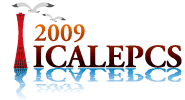ICALEPCS 2009
THC005
SLIDE
The Implementation of the Software Framework in J-PARC/MLF
T.Hosoya (Ibaraki University Department of Functional Biomolecular Engineering) M.Yonemura (Ibaraki University Graduate School of Science and Engineering) H.Nakagawa, T.Ohhara (JAEA) A.Arai, R.K.Kajimoto, S.Harjo, T.Ito, T.Nakatani*, Y.Inamura (JAEA/J-PARC) T.Aoyagi (Japan Atomic Energy Agancy Center for Computational Science & e-Systems) J.Suzuki, O.Otomo, R.Kadono, S.Muto, S.Torii, T.Morishima, Y.Yasu (KEK)
In the neutron scattering experiments, it is necessary to use many kinds of software components such as the data acquisition, equipment control, analysis and visualization. Additionally, in J-PARC/MLF, because the proton intensity will increase more and more, we will have to extend the capacity of the software to keep in the step. Therefore, the software is necessarily flexible and scalable for the various experiments and the enormous data (several tens of giga-bytes per hour). We have constructed the common software framework and then made many software components running on this software framework. Our software framework is based on Python which is an object oriented script language and the distributed network processing with XML messages over HTTP, for example the "RESTful" data acquisition and equipment control system. Through our software framework, not only the experimental users can seamlessly operate the neutron experimental instruments and analyze their acquired data but also the instrument scientists can coordinate the instruments and manage their configuration. In this presentation, we report the detailed implementation of our software framework.

